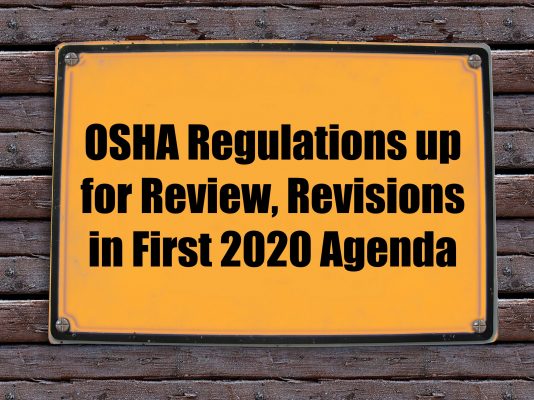OSHA Regulations up for Review, Revisions in First 2020 Agenda

OSHA has listed 24 regulations for review in its first Regulatory Agenda of 2020. Standards covering cranes and derricks, beryllium, forklifts, silica, and workplace violence are on the agenda.
Here’s a breakdown by stage in the regulatory process:
Final rules
These are among the standards which are closest to the finish line for revisions:
- Exposure to beryllium, review general industry provisions: The revisions OSHA proposes are to clarify the standard in response to comments. OSHA is reviewing comments received.
- Occupational exposure to beryllium and beryllium compounds in construction and shipyard sectors: Exposure to construction and shipyards occurs almost entirely during abrasive blasting and welding. The proposal would tailor the requirements for construction and shipyards to those exposures.
- OSHA access to employee medical records: OSHA’s regulation 1913.10 includes procedures for OSHA personnel when obtaining and using personally identifiable employee medical information. OSHA has identified several needed revisions.
Proposed rules
OSHA is working on revisions to these standards, but they’re further away from completion:
- Amendments to the Cranes and Derricks in Construction Standard: This would make various clarifications to the standard. Notice of Proposed Rulemaking (NPRM) scheduled July 2020.
- Update to Hazard Communication Standard: This would harmonize the HCS to the latest edition of the Globally Harmonized System of Classification and Labeling of Chemicals. NPRM scheduled for August 2020.
- Powered industrial trucks: OSHA will develop a proposed rule updating the consensus standard of the American National Standard B56.1 to the 2016 version. NPRM scheduled December 2020.
- Lockout/tagout update: OSHA would take into account recent technology advances that use computer-based controls of hazardous energy and make changes to its existing lockout/tagout standard. NPRM scheduled April 2021.
- Exposure to crystalline silica, revisions to Table 1 for construction: OSHA is interested in control measures, tasks, and tools, and dust control methods not addressed in Table 1, Specified Exposure Control Methods When Working with Materials Containing Crystalline Silica. NPRM scheduled March 2021.
- Welding in construction confined spaces: OSHA wants to eliminate any ambiguity about the definition of confined space that applies to welding in construction. NPRM scheduled July 2020.
- Drug Testing Program and Safety Incentives Rule: OSHA proposes to make official its position that its regulations don’t prohibit post-incident drug testing or safety incentive
programs. NPRM scheduled November 2020. - Personal protective equipment in construction: This revision would clarify the requirement for the fit of PPE in construction. NPRM scheduled August 2020.
- Walking working surfaces: OSHA has received feedback indicating that several regulatory provisions of the 2016 final rule on Walking-Working Surfaces are unclear. NPRM June 2020.
Related Posts




